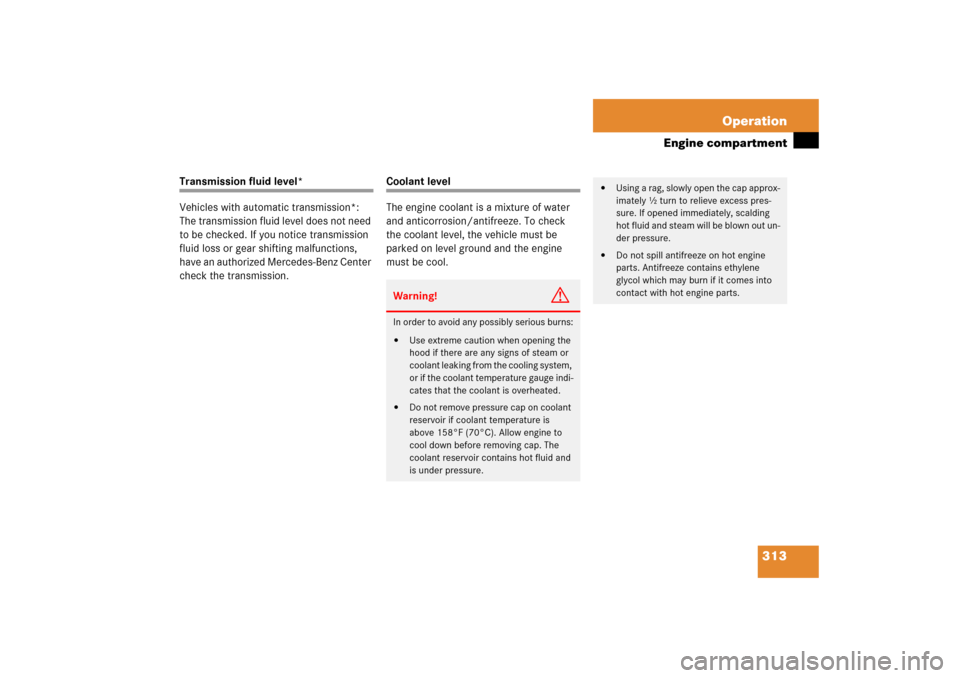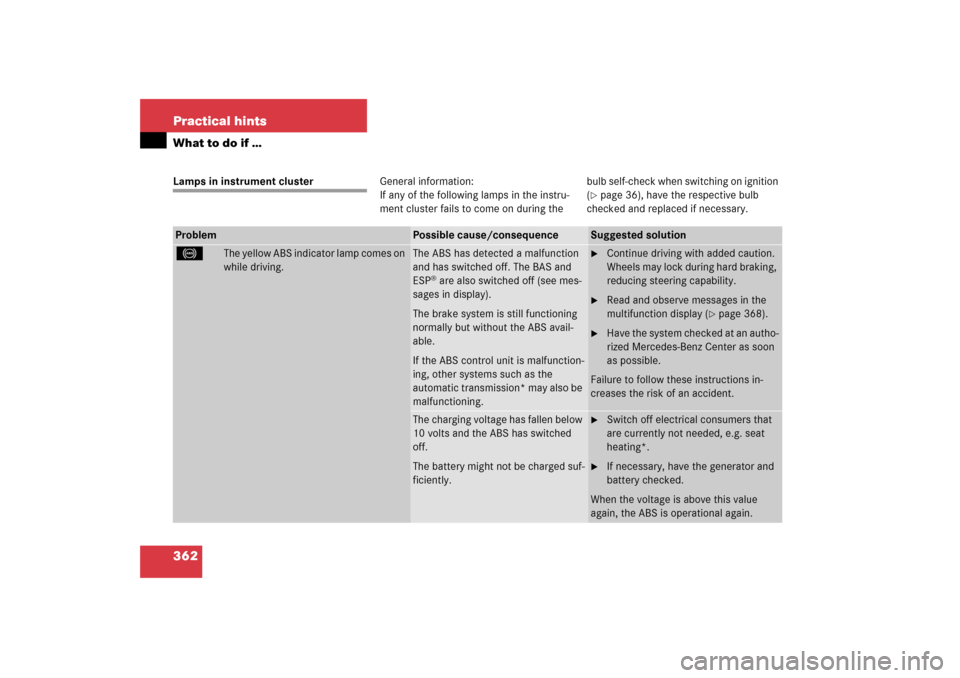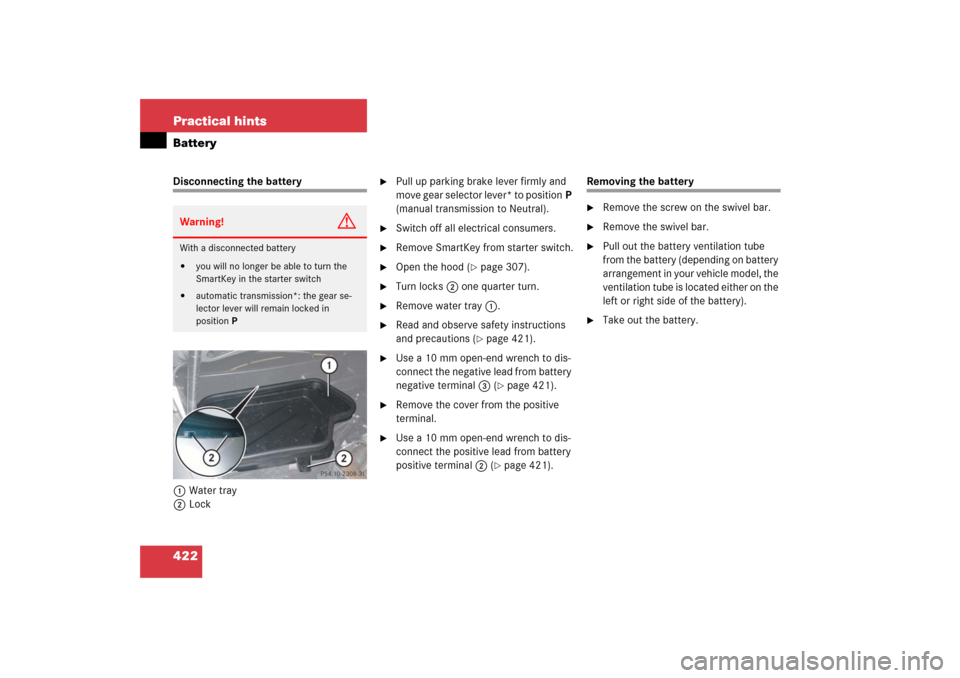Page 301 of 481

300 OperationDriving instructionsRoad salts and chemicals can adversely af-
fect braking efficiency. Increased pedal
force may become necessary to produce
the normal brake effect.
Depressing the brake pedal periodically
when traveling at length on salt-strewn
roads can bring road-salt-impaired braking
efficiency back to normal.
If the vehicle is parked after being driven
on salt-treated roads, the braking efficien-
cy should be tested as soon as possible af-
ter driving is resumed.
For more information, see “Winter driving”
(
�page 348).
Standing water
Warning!
G
Make sure not to endanger any other road
users when carrying out these braking ma-
neuvers.
Warning!
G
If the vehicle becomes stuck in snow, make
sure snow is kept clear of the exhaust pipe
and from around the vehicle with the engine
running. Otherwise, deadly carbon monox-
ide (CO) gases may enter the vehicle interi-
or, resulting in unconsciousness and death.
To assure sufficient fresh air ventilation,
open a window slightly on the side of the ve-
hicle not facing the wind.Warning!
G
The outside temperature indicator is not de-
signed to serve as an ice-warning device and
is therefore unsuitable for that purpose. In-
dicated temperatures just above the freez-
ing point do not guarantee that the road
surface is free of ice.
!Do not drive through flooded areas or
water of unknown depth. Before driving
through water, determine its depth.
Never accelerate before driving into
water. The bow wave could force water
into the engine and auxiliary equip-
ment, thus damaging them.
If you must drive through standing wa-
ter, drive slowly to prevent water from
entering the passenger compartment
or the engine compartment. Water in
these areas could cause damage to
electrical components or wiring of the
engine or transmission, or could result
in water being ingested by the engine
through the air intake, causing severe
internal engine damage. Any such dam-
age is not covered by the
Mercedes-Benz Limited Warranty.
Page 314 of 481

313 Operation
Engine compartment
Transmission fluid level*
Vehicles with automatic transmission*:
The transmission fluid level does not need
to be checked. If you notice transmission
fluid loss or gear shifting malfunctions,
have an authorized Mercedes-Benz Center
check the transmission.
Coolant level
The engine coolant is a mixture of water
and anticorrosion/antifreeze. To check
the coolant level, the vehicle must be
parked on level ground and the engine
must be cool.Warning!
G
In order to avoid any possibly serious burns:�
Use extreme caution when opening the
hood if there are any signs of steam or
coolant leaking from the cooling system,
or if the coolant temperature gauge indi-
cates that the coolant is overheated.
�
Do not remove pressure cap on coolant
reservoir if coolant temperature is
above 158°F (70°C). Allow engine to
cool down before removing cap. The
coolant reservoir contains hot fluid and
is under pressure.
�
Using a rag, slowly open the cap approx-
imately ½ turn to relieve excess pres-
sure. If opened immediately, scalding
hot fluid and steam will be blown out un-
der pressure.
�
Do not spill antifreeze on hot engine
parts. Antifreeze contains ethylene
glycol which may burn if it comes into
contact with hot engine parts.
Page 345 of 481

344 OperationTires and wheelsTire and loading terminology
Accessory weight
The combined weight (in excess of those
standard items which may be replaced) of
automatic transmission, power steering,
power brakes, power windows, power
seats, radio, and heater, to the extent that
these items are available as
factory-installed equipment (whether
installed or not).
Air pressure
The amount of air inside the tire pressing
outward on each square inch of the tire.
Air pressure is expressed in pounds per
square inch (psi), or kilopascal (kPa), or
bars.
Aspect ratio
Dimensional relationship between tire
section height and section width
expressed in percentage.Bar
Another metric unit for air pressure. There
are 14.5038 pounds per square inch (psi)
to 1 bar; there are 100 kilopascals (kPa)
to 1 bar.
Bead
The tire bead contains steel wires wrapped
by steel cords that hold the tire onto the
rim.
Cold tire inflation pressure
Tire inflation pressure when your vehicle
has been sitting for at least three hours or
driven no more than one mile (1.6 km).
Curb weight
The weight of a motor vehicle with stan-
dard equipment including the maximum
capacity of fuel, oil, and coolant, and, if so
equipped, air conditioning and additional
optional equipment, but without passen-
gers and cargo.DOT (D
epartment o
f T
ransportation)
A tire branding symbol which denotes the
tire meets requirements of the
U.S. Department of Transportation.
GAWR (G
ross A
xle W
eight R
ating)
The GAWR is the maximum permissible
axle weight. The gross vehicle weight on
each axle must never exceed the GAWR for
the front and rear axle indicated on the
certification label located on the driver’s
door B-pillar.
GVW (G
ross V
ehicle W
eight)
The GVW comprises the weight of the
vehicle including fuel, tools, spare wheel,
installed accessories, passengers and
cargo and, if applicable, trailer tongue
load. The GWV must never exceed the
GWVR indicated on the certification label
located on the driver’s door B-pillar.
Page 363 of 481

362 Practical hintsWhat to do if …Lamps in instrument clusterGeneral information:
If any of the following lamps in the instru-
ment cluster fails to come on during thebulb self-check when switching on ignition
(
�page 36), have the respective bulb
checked and replaced if necessary.
Problem
Possible cause/consequence
Suggested solution
-
The yellow ABS indicator lamp comes on
while driving.
The ABS has detected a malfunction
and has switched off. The BAS and
ESP
® are also switched off (see mes-
sages in display).
The brake system is still functioning
normally but without the ABS avail-
able.
If the ABS control unit is malfunction-
ing, other systems such as the
automatic transmission* may also be
malfunctioning.
�
Continue driving with added caution.
Wheels may lock during hard braking,
reducing steering capability.
�
Read and observe messages in the
multifunction display (
�page 368).
�
Have the system checked at an autho-
rized Mercedes-Benz Center as soon
as possible.
Failure to follow these instructions in-
creases the risk of an accident.
The charging voltage has fallen below
10 volts and the ABS has switched
off.
The battery might not be charged suf-
ficiently.
�
Switch off electrical consumers that
are currently not needed, e.g. seat
heating*.
�
If necessary, have the generator and
battery checked.
When the voltage is above this value
again, the ABS is operational again.
Page 373 of 481
372 Practical hintsWhat to do if …Display message
Possible cause/consequence
Possible solution
ESP
Display malfunction
Visit workshop
The ESP
® or the ESP
® display is mal-
functioning.
�
Continue driving with added caution.
�
Visit an authorized Mercedes-Benz Center
as soon as possible.
Failure to follow these instructions increases
the risk of an accident.
SRS
Restraint system
malfunction
Drive to workshop
The SRS system is malfunctioning.
�
Drive with added caution to the nearest
authorized Mercedes-Benz Center.
Transmis-
sion
Visit workshop
Vehicles with automatic transmis-
sion*:
The provided operating safety of the
automatic transmission is reduced.
�
Drive with added caution to the nearest
authorized Mercedes-Benz Center.
Page 397 of 481
396 Practical hintsUnlocking/locking in an emergency1Locking�
Insert the mechanical key into the
driver’s door lock until it stops.
�
Turn the mechanical key clockwise to
position1.
The driver’s door is locked.Manually unlocking the gear selector
lever (automatic transmission*)
In case of power failure, the gear selector
lever can be manually unlocked, e.g. to tow
the vehicle.
1Gear selector lever cover
2Release
�
Insert flat, blunt object (e.g. screwdriv-
er) into the left edge of cover1 at the
position indicated by the arrows.
�
Loosen cover1 using this object.
�
Using your hands, pull cover1 out
and remove.
�
Push down and hold release2 in di-
rection of arrow.
�
Simultaneously move gear selector le-
ver out of positionP.
The gear selector lever is unlocked
now.iThe gear selector lever is locked again
as soon as you place it in positionP
again.
��
Page 409 of 481
408 Practical hintsFlat tireThe SLK 55 AMG with Performance
Package* is equipped with a TIREFIT kit.Preparing the vehicle�
Park the vehicle as far as possible from
moving traffic on a hard surface.
�
Turn on the hazard warning flashers.
�
Turn the steering wheel so that the
front wheels are in a straight ahead po-
sition.
�
Set the parking brake (
�page 52).
�
Move the gear selector lever* toP
(manual transmission to first or reverse
gear).
�
Turn off the engine (
�page 61).
�
Remove the SmartKey from the starter
switch.
�
Have any passenger exit the vehicle at
a safe distance from the roadway.
Sealing tires with TIREFIT
Small tire punctures, particularly those in
the tread, can be sealed with TIREFIT.
TIREFIT can be used in ambient tempera-
tures down to -4°F (-20°C).
iOpen door only when conditions are
safe to do so.
iSLK 55 AMG with Performance
Package* only.Warning!
G
Keep TIREFIT away from sparks, open flame
or heat source.
Do not smoke.
Page 423 of 481

422 Practical hintsBatteryDisconnecting the battery
1Water tray
2Lock
�
Pull up parking brake lever firmly and
m o v e g e a r s e l e c t o r l e v e r * t o p o s i t i o nP
(manual transmission to Neutral).
�
Switch off all electrical consumers.
�
Remove SmartKey from starter switch.
�
Open the hood (
�page 307).
�
Turn locks2 one quarter turn.
�
Remove water tray1.
�
Read and observe safety instructions
and precautions (
�page 421).
�
Use a 10 mm open-end wrench to dis-
connect the negative lead from battery
negative terminal3 (
�page 421).
�
Remove the cover from the positive
terminal.
�
Use a 10 mm open-end wrench to dis-
connect the positive lead from battery
positive terminal2 (
�page 421).
Removing the battery�
Remove the screw on the swivel bar.
�
Remove the swivel bar.
�
Pull out the battery ventilation tube
from the battery (depending on battery
arrangement in your vehicle model, the
ventilation tube is located either on the
left or right side of the battery).
�
Take out the battery.
Warning!
G
With a disconnected battery�
you will no longer be able to turn the
SmartKey in the starter switch
�
automatic transmission*: the gear se-
lector lever will remain locked in
positionP